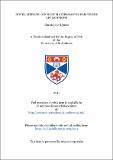Files in this item
Novel lithium-ion host materials for electrode applications
Item metadata
| dc.contributor.advisor | Bruce, Peter G. | |
| dc.contributor.author | Lyness, Christopher | |
| dc.coverage.spatial | 238 | en_US |
| dc.date.accessioned | 2011-07-19T13:37:02Z | |
| dc.date.available | 2011-07-19T13:37:02Z | |
| dc.date.issued | 2011-06-22 | |
| dc.identifier | uk.bl.ethos.552506 | |
| dc.identifier.uri | https://hdl.handle.net/10023/1921 | |
| dc.description.abstract | Two novel lithium host materials were investigated using structural and electrochemical analysis; the cathode material Li₂CoSiO₄ and the LiMO₂ class of anodes (where M is a transition metal ion). Li₂CoSiO₄ materials were produced utilising a combination of solid state and hydrothermal synthesis conditions. Three Li₂CoSiO₄ polymorphs were synthesised; β[subscript(I)], β[subscript(II)] and γ₀. The Li₂CoSiO₄ polymorphs formed structures based around a distorted Li₃PO₄ structure. The β[subscript(II)] material was indexed to a Pmn2₁ space group, the β[subscript(I)] polymorph to Pbn2₁ and the γ₀ material was indexed to the P2₁/n space group. A varying degree of cation mixing between lithium and cobalt sites was observed across the polymorphs. The β[subscript(II)] polymorph produced 210mAh/g of capacity on first charge, with a first discharge capacity of 67mAh/g. It was found that the β[subscript(I)] material converted to the β[subscript(II)] polymorph during first charge. The γ₀ polymorph showed almost negligible electrochemical performance. Capacity retention of all polymorphs was poor, diminishing significantly by the tenth cycle. The effect of mechanical milling and carbon coating upon β[subscript(II)], β[subscript(I)] and γ₀ materials was also investigated. Various Li[subscript(1+x)]V[subscript(1-x)]O₂ materials (where 0≤X≤0.2) were produced through solid state synthesis. LiVO₂ was found to convert to Li₂VO₂ on discharge, this process was found to be strongly dependent on the amount of excess lithium in the system. The Li₁.₀₈V₀.₉₂O₂ material had the highest first discharge capacity at 310mAh/g. It was found that the initial discharge consisted of several distinct electrochemical processes, connected by a complicated relationship, with significant irreversible capacity on first discharge. Several other LiMO₂ systems were investigated for their ability to convert to layered Li₂MO₂ structures on low voltage discharge. While LiCoO₂ failed to convert to a Li₂CoO₂ structure, LiMn₀.₅Ni₀.₅O₂ underwent an addition type reaction to form Li₂Mn₀.₅Ni₀.₅O₂. A previously unknown Li₂Ni[subscript(X)]Co[subscript(1-X)]O₂ structure was observed, identified during the discharge of LiNi₀.₃₃Co₀.₆₆O₂. | en_US |
| dc.language.iso | en | en_US |
| dc.publisher | University of St Andrews | |
| dc.subject | Lithium-ion | en_US |
| dc.subject | Silicate cathode | en_US |
| dc.subject | LiVO₂ | en_US |
| dc.subject | Li₂CoSiO₄ | en_US |
| dc.subject | Transition metal oxide anode | en_US |
| dc.subject.lcc | TK2945.L58L8 | |
| dc.subject.lcc | TK2945.L58L8 | |
| dc.subject.lcsh | Lithium ion batteries | en_US |
| dc.subject.lcsh | Cathodes--Materials | en_US |
| dc.subject.lcsh | Anodes--Materials | en_US |
| dc.subject.lcsh | Lithium compounds | en_US |
| dc.subject.lcsh | Transition metal oxides | en_US |
| dc.title | Novel lithium-ion host materials for electrode applications | en_US |
| dc.type | Thesis | en_US |
| dc.type.qualificationlevel | Doctoral | en_US |
| dc.type.qualificationname | PhD Doctor of Philosophy | en_US |
| dc.publisher.institution | The University of St Andrews | en_US |
This item appears in the following Collection(s)
Items in the St Andrews Research Repository are protected by copyright, with all rights reserved, unless otherwise indicated.

